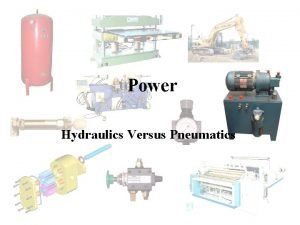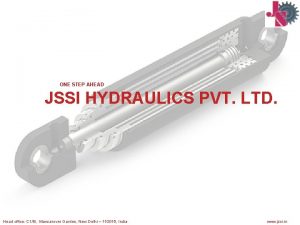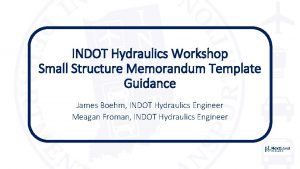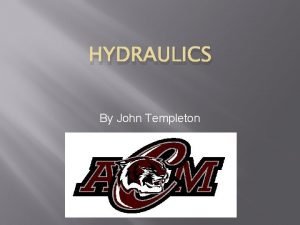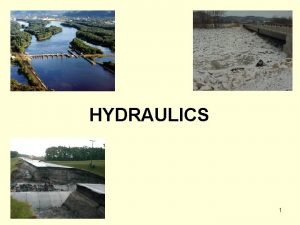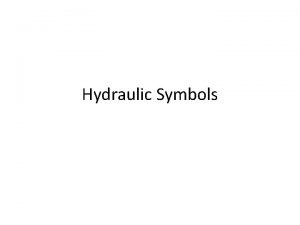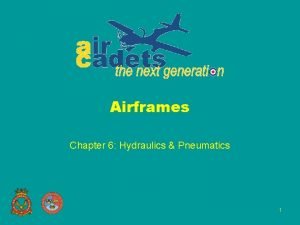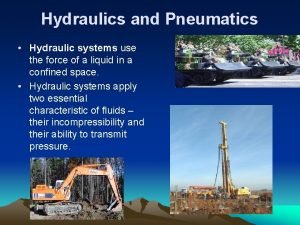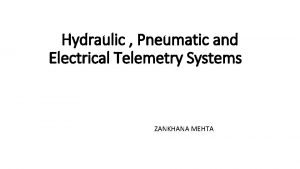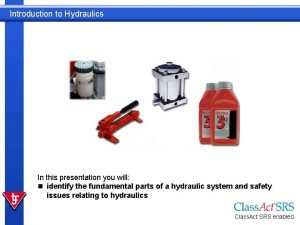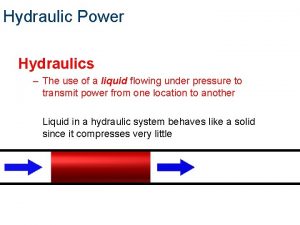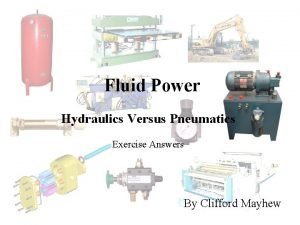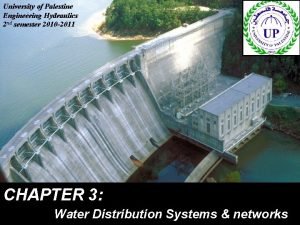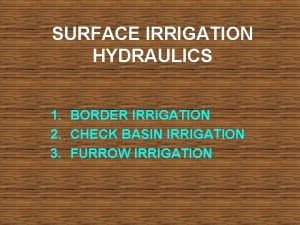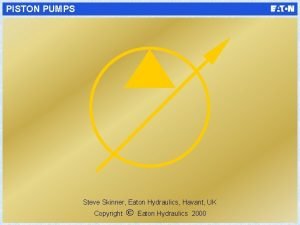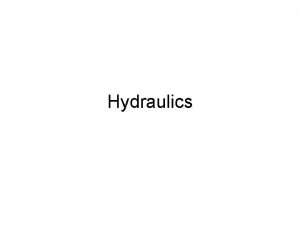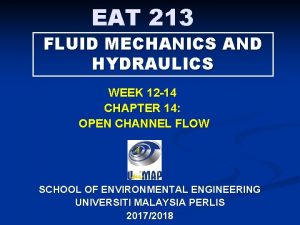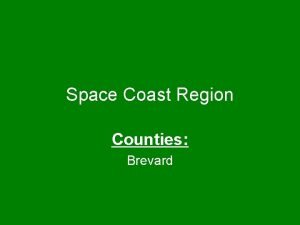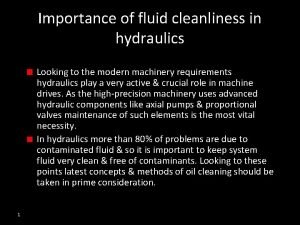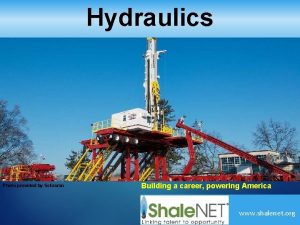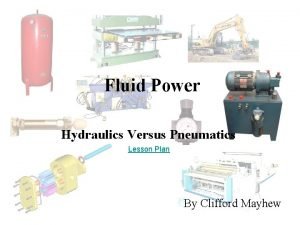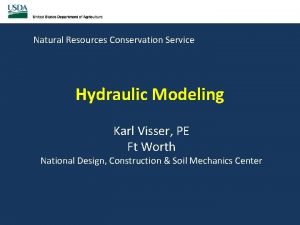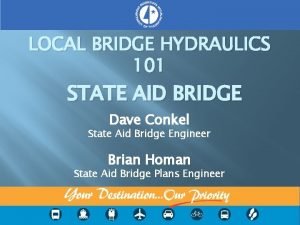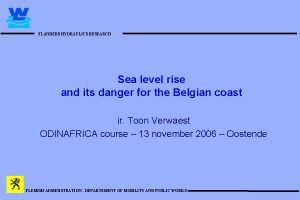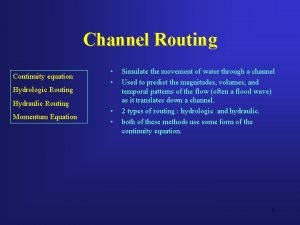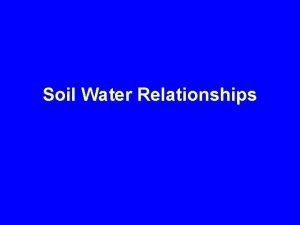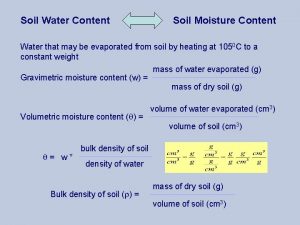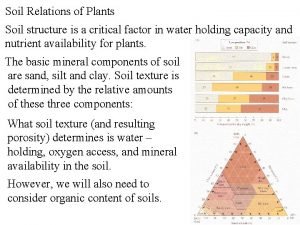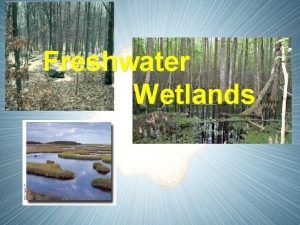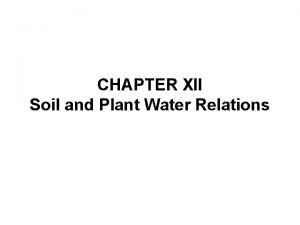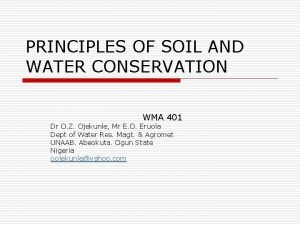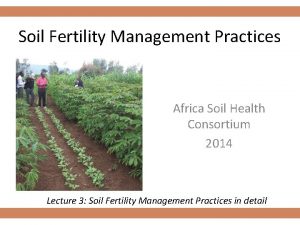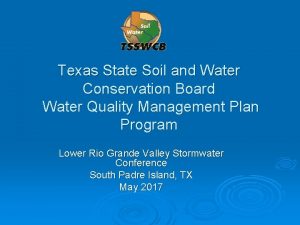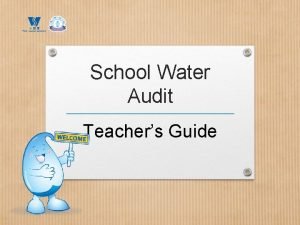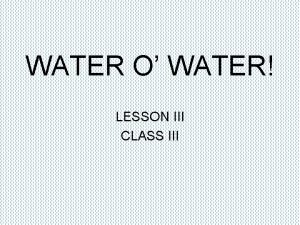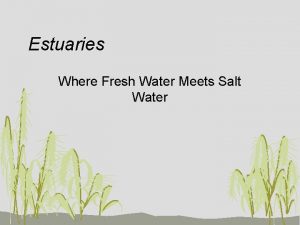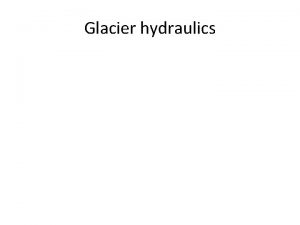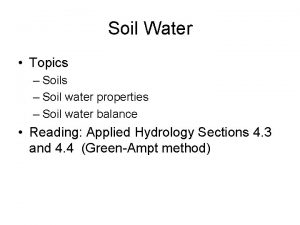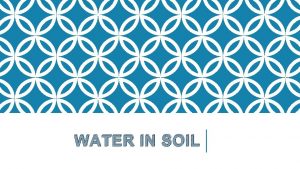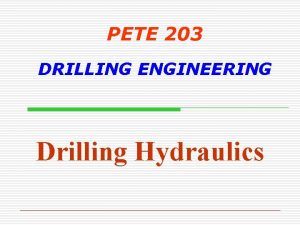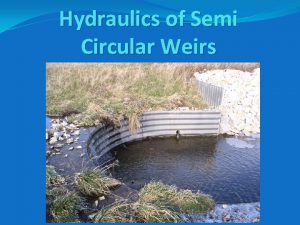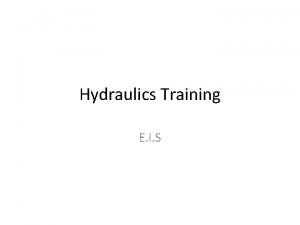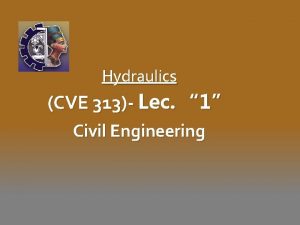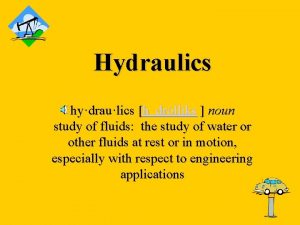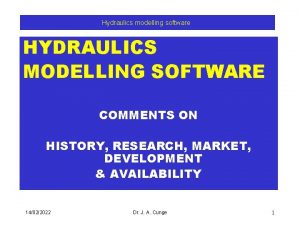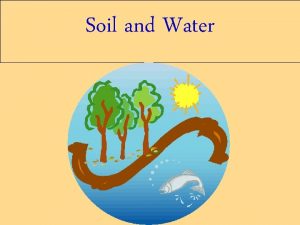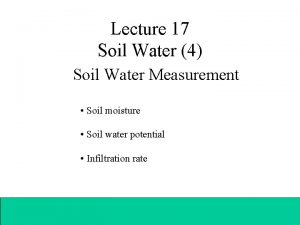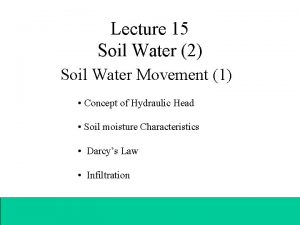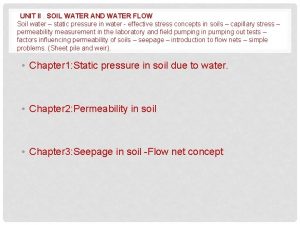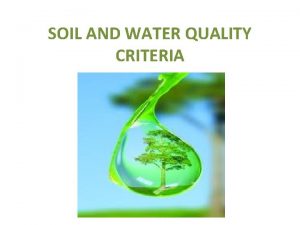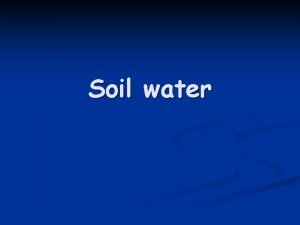Week 2 3 Soil Soil Water Soil Hydraulics




























































- Slides: 60

Week 2 -3: Soil, Soil Water, Soil Hydraulics • Upon completion of this topic, student would be able to: – A brief definition of soil – appraise the important of soil in agricultural and non-agricultural production – Obtain general relationship between soil and water resources – Understand some basic soil terminology used in water resources planning and management PDT 379 Soil, Soil Water, Soil Hydraulics 1

The soil is the nation • Soil is something you can explore with your senses, see it, feel it, smell it, taste it • Without soil, we – Wouldn’t have plant/crops/agriculture • Without plants/crops, we – Wouldn’t have people • Without people, we – Wouldn’t have the nation/country PDT 379 Soil, Soil Water, Soil Hydraulics 2

Reasons why studying soil • • Soils influences most of your daily life Built house on soil Steps/walks on soil Growing crops on soil Burry in soil Made of soil Fighting/war for more soil PDT 379 Soil, Soil Water, Soil Hydraulics 3

The important of soil • Medium of plant growth – The unconsolidated mineral matter on the immediate surface of the earth that serves as natural medium for the growth of land plants Physical support To plant Water to plant Nutrient to plant O 2 to root PDT 379 Soil, Soil Water, Soil Hydraulics 4

Soil is a natural body • The unconsolidated material on surface of the earth that has been subjected to and influenced by genetic and environmental factor of climate and organism acting upon parent materials • 5 basic soil forming factors: – Climate – Organism – Relief – Parent materials – Time factor PDT 379 Soil, Soil Water, Soil Hydraulics 5

Soil is a natural resources • Soils are the skin of the earth • Soils (pedosphere) links the other spheres of earth’s environment • Soil is an important construction materials for human and animal habitat Biosphere Pedoshere Atmosphere Hydrosphere Lithosphere PDT 379 Soil, Soil Water, Soil Hydraulics 6

Conclusions about Soil • Whether our interest is plant production, environmental protection, land-use planning, civil engineering or water resource engineering, you need to be knowledgeable in “the affair of the soil” • That the reason why we have subjects such as: – – – Soil science (general) Soil mechanics (civil & Biosys Eng) Soil physics (Civil, Bio, Agric) Soil chemistry (Agric, Bio) Soil conservation (Agric, Bio) Soil dynamics (Civil, mech, Biosys) • Soil & Water are co-exist, that’s the reason why we study this subject, Soil & Water Engineering PDT 379 Soil, Soil Water, Soil Hydraulics 7

What is soil? • Soils is a mixture of solids, liquids and gases • Solid consists of minerals and organic matters OM (5%) Mineral (45%) Solid phase Liquid (15 -100%) Gasses/Air (0 -85%) Pore phase PDT 379 Soil, Soil Water, Soil Hydraulics 8

What is soil • Soils is colorful • As with people, soils is colorful; red, brown, black, white, grey, motted, olive, green, blue, purple Munsell Soil Color Chart PDT 379 Soil, Soil Water, Soil Hydraulics 9

Soil is structured • Soil particles are formed into idealized soil structural units called Ped (aggregates) with various shape; granular, blocky, prismatic, platy • The arrangement of the aggregates plays a significant role in water, air and plant root movement through soil PDT 379 Soil, Soil Water, Soil Hydraulics 10

Soil is layered & 3 -D • Soil profiles show that soils can be layered like a cake • Soil is a 3 -D (Pedon). • a "Pedon" as a 3 -D structure (minimum 1 m 2 surface up to 10 m 2) that contain all the properties of the studied soil. PDT 379 Soil, Soil Water, Soil Hydraulics 11

Soil is highly variable • Soils may be similar but are never identical, depending on landscape, parent materials, climate, vegetation, etc. PDT 379 Soil, Soil Water, Soil Hydraulics 12

BREAK PDT 379 Soil, Soil Water, Soil Hydraulics 13

Soil physical properties • Upon completion of this topic, student would be able to: – Describe the fundamental aspect of physical and mineralogical properties of soil (Moisture, density, porosity) and their effect to plant growth – Classify the soil type according to their textural component using the International Code, Agricultural Code (USDA) and non-agricultural Code (BS) PDT 379 Soil, Soil Water, Soil Hydraulics 14

Particle Size and Texture • After the completion of this topics, students should be able to: – Use the textural triangle to determine the soil textural class of a soil – Estimate soil textural class using the feel method PDT 379 Soil, Soil Water, Soil Hydraulics 15

Soil particles • Soil particles (separates) are divided into three general classes based on the diameter of the particle, i. e. sand, silt & Clay – Sand, the largest sized 0. 05 -2. 00 mm diameter, having surface area=11 cm 2/g, feel gritty (cekal) – Clay, the smallest, sized <0. 002 mm diameter, having surface area 11, 000 cm 2/g, feel sticky (melekit) – Silt, the intermediate, sized 0. 002 -0. 05 mm diameter, having surface area 450 cm 2/g, feel smooth like flour (licin) PDT 379 Soil, Soil Water, Soil Hydraulics 16

Soil Texture/Particle Size Distribution • Describes the relative proportions of sand, silt and clay particles in a soil • Why Particle size? – Particle size represents the total surface area of the soil. – Many important relation that occur in the soil (weathering, water retention, nutrient exchange) occur at the surface of the particles contact the surrounding air and water • Terminology – Soil textural analysis – agricultural engineering – Grain size Distribution – civil engineering • Code – Agriculture – USDA, Textural triangle – Engineering – Grain size distribution curve PDT 379 Soil, Soil Water, Soil Hydraulics 17

Particle size-Surface Area Relationship • Imagine a soil particle size 1 cm x 1 cm (Vol=1 cm 3) – what is the total surface area of the particle? 1 cm 2 x 6= 6 cm 2 • Imagine if the same volume of soil having smaller particle size, say 0. 5 cmx 0. 5 cm – What is the total surface area of the particle contain in 1 cm 3 of soil? PDT 379 Soil, Soil Water, Soil Hydraulics 1 cm 1 cm 0. 5 cm 18

Particle size classification Fraction Particle Diameter /Mesh size (mm) Gravel >2. 0 Coarse Sand 0. 2 -2. 0 Fine Sand 0. 02 -0. 20 Silt 0. 002 -0. 02 Clay < 0. 002 PDT 379 Soil, Soil Water, Soil Hydraulics 19

Why Textural Class of Soil Important? • Is a diagnostic properties of the soil • Knowing the texture, can allow to make many inferences about important properties & characteristic of soil Property Sand Silt Clay Porosity Low Modera te High Water holding capacity L M H Infiltration rate H M L Drainage Good Modera te Poor Ability to store nutrient L M H Shrink-swell potential L M H Compactibility L M H Root penetration G M P tillage operation G M P transportability P M E Susceptibility to water erosion H M L Sealing pond/dam P P G Pollutant leaching H M L PDT 379 Soil, Soil Water, Soil Hydraulics 20

How is Texture Determined? • 2 methods • Method A: The feel method – Rubbed between fingers – Require skill, practices, experience – Quite subjective • Method B: Sieve & Sedimentation method – A more quantitative, scientific, accurate – Breaking up any soil aggregates and disperse the soil particles, then separate the by sieving and sedimentation approaches – Sieving is only effective for particle size > 0. 05 mm – Sedimentation would provide a more detail analysis especially for particle size <0. 05 mm (Silt & Clay) PDT 379 Soil, Soil Water, Soil Hydraulics 21

Sieve Method • Equipment Required – Scientific balance sensitive to 0. 01 g – A complete set of standard sieves of size number 4 (4. 75 mm), 10 (2 mm), 20 (0. 85 mm), 40 (0. 425 mm), 80 (0. 180 mm), 100 (0. 150 mm), 200 (0. 075 mm), a pan (<0. 075 mm) – A sieve shaker with timer PDT 379 Soil, Soil Water, Soil Hydraulics 22

Sieve Method A: Sample Preparation 1. Obtain the natural soil sample (wet) from the field 2. Prepare air-dried soil sample (Put the wet sample on newspaper under the room temperature, no aircond, no sunlight for few days) 3. Crush the air dried soil sample to break-up the aggregate 4. Obtain an amount (300 -500 g) of air-dry crushed soil sample 5. Avoid losing small or large particles from the sample 6. Weigh the sample to the nearest 0. 01 g PDT 379 Soil, Soil Water, Soil Hydraulics 23

B. Sieving process 1. Put the sample into the top of a stack of standard sieve. The largest mesh should be on top and pan on the bottom 2. Shake the sieve (vertically & horizontally) until there is less than a one percent change in the weight of the material on a sieve 3. When shaking is complete, weigh the amount of material retained on each sieve 4. The sum of all the weights should be nearly equal to the weight of the original sample PDT 379 Soil, Soil Water, Soil Hydraulics 24

Particle size estimation 1. Determine the cumulative weight retained by adding the weights retained on each screen. 2. Establish the computation table 3. Plot particle/grain size distribution curve on semi-log paper with the linear y-axis (% finer) and x-axis (particle size) 4. Determine the soil textural Classification using USDA-Triangle Diagram PDT 379 Soil, Soil Water, Soil Hydraulics 25

PDT 379 Soil, Soil Water, Soil Hydraulics 26

PDT 379 Soil, Soil Water, Soil Hydraulics 27

PDT 379 Soil, Soil Water, Soil Hydraulics 28

Eg. Sieve analysis Tabulation Sieve Number Sieve size (mm) Weight Retained (g) Cumulative Retained 4 4. 75 0 0 10 2. 00 0 0 100 20 0. 850 9. 10 87 40 0. 425 16. 95 26. 05 64 80 0. 180 23. 40 49. 45 31 100 0. 150 17. 30 66. 75 7 200 0. 075 3. 90 70. 65 2 pan -- 1. 31 71. 97 0 Total Original Weight Loss % Finer 71. 97 72. 00 0. 03 PDT 379 Soil, Soil Water, Soil Hydraulics 29

Particle Size/Grain size Distribution Curve PDT 379 Soil, Soil Water, Soil Hydraulics 30

Grain size Distribution Curve • Several useful parameters (sufficient for civil engineering related work) can be derived – Median size D 50 (diameter of soil particles at which 50% passes) – Effective size, D 10 – Coefficient of Uniformity, Cu=(D 60/D 10) – Coefficient of Curvature, Cc =(D 30)2/(D 60 D 10) • For Agricultural engineering work, a more detail textural analysis is required before the textural classes of the soil can be determined • Thus, the hydrometer method was introduced PDT 379 Soil, Soil Water, Soil Hydraulics 31

Soil Texture: Hydrometer/Sedimentation Method • Sieving method is only effective to a particle size of 0. 05 mm and larger, so it works best for separating sand the sand particle from silt and clay • Sedimentation method is meant for separating the soil texture in further detail especially silt-clay component • Applying the Stoke’s Law on the time taken for a particular particle size to settle down is a function of particle’s diamater v=velocity (mm/s) h = distance the falling travel (m) d = effective diameter of particle (m) g = gravitational force (9. 81 Newtons/kg) ps = density of particle (2. 65 g/cm 3) pl = density of water (1. 0 g/cm 3) ɳ = viscosity of water (1 x 10 -3 Newton-sec/m 2) PDT 379 Soil, Soil Water, Soil Hydraulics 32

Hydrometer Method: Procedures • Principle: – Hydrometer method involves reading the density of the soil-water suspension at pre-determined times with a hydrometer – The density of the suspension decreases as the larger, heavier soil particle settle out – The density of the solution at the pre-determined times is proportional to the sand, silt, and clay remaining in suspension. PDT 379 Soil, Soil Water, Soil Hydraulics 33

Hydrometer Method: Procedures • Equipment: a) b) c) d) Hydrometer 1000 ml sedimentation cylinder Thermometer Dispersion agent, Sodium hexametaphosphate solution (40 g/l buffered to p. H 8 -9 with sodium carbonate) or 5% Calgon Solution e) Plunger PDT 379 Soil, Soil Water, Soil Hydraulics 34

Hydrometer Method: Procedures 1. 2. 3. 4. 5. 6. 7. 8. Disperse 50 g of 2 mm sieved air-dried in water and dilute to 1 liter in a sedimentation cylinder Add a 100 ml of dispersing agent (5% Calgon solution) and stir with plunger and Insert the hydrometer after 30 seconds Read the g of silt and clay on hydrometer after 45 seconds (sand-sized particles have already settled out) Read the g of clay after 478 minutes (silt-sized particles have sett of silt and led out) Determine the g of sand silt by difference 50 g –t 45 sec = g sand t 45 sec-t 478 min = g silt Knowing the percentage of Sand, Silt and Clay by weight, the textural classes of the soil can be determine using the Triangle Textural Classification PDT 379 Soil, Soil Water, Soil Hydraulics 30 sec 478 min 45 sec 35

Soil Triangle PDT 379 Soil, Soil Water, Soil Hydraulics 36

PDT 379 Soil, Soil Water, Soil Hydraulics 37

PDT 379 Soil, Soil Water, Soil Hydraulics 38

PDT 379 Soil, Soil Water, Soil Hydraulics 39

PDT 379 Soil, Soil Water, Soil Hydraulics 40

EXERCISE • What type of soil is made of 10% sand, 80% clay and 10% silt? • What type of soil is made of 60% soil, 10% silt and 30% clay? • What type of soil is made of 50% sand, 40% clay and 10% silt? • What kind of soil is made of 40% sand, 40% silt and 20% clay? It is the best soil for most plant. PDT 379 Soil, Soil Water, Soil Hydraulics 41

Soil Physical Properties • The basic soil physical properties include – Void ratio – Porosity – Specific gravity – Degree of saturation – Unit weight – Moisture content • Only moisture content, unit weight and specific gravity are determined in the laboratory • Void ratio, porosity and degree of saturation are not directly determined PDT 379 Soil, Soil Water, Soil Hydraulics 42

BREAK PDT 379 Soil, Soil Water, Soil Hydraulics 43

Soil is a three-phase system Volume of Void = Vol of Water + Vol of Air Volume of solid + vol of void = Total volume of soil When void is filled with water = saturated PDT 379 Soil, Soil Water, Soil Hydraulics 44

Basic soil engineering properties • PDT 379 Soil, Soil Water, Soil Hydraulics 45

Particle Density/Specific Gravity & Bulk Density • PDT 379 Soil, Soil Water, Soil Hydraulics 46

Bulk density Determination • PDT 379 Soil, Soil Water, Soil Hydraulics 47

BREAK PDT 379 Soil, Soil Water, Soil Hydraulics 48

Soil-water-plant Relationship • Upon completion of this topic, student would be able to: – Describe the fundamental properties of soil water in relation to crop water requirement – Determine the crop water requirement based on soil water holding capacity PDT 379 Soil, Soil Water, Soil Hydraulics 49

Soil and Water • Soil acts as a “water reservoir” for plants • Soil is so important to plant because of its ability to supply water to plant at reasonable duration • The water in the soil exist in various stages according to the soil water potential (pressure) • The soil water potential indicates the strength of a soil to hold water PDT 379 Soil, Soil Water, Soil Hydraulics 50

What is Soil Moisture, w • PDT 379 Soil, Soil Water, Soil Hydraulics 51

Moisture Content (MC) determination • PDT 379 Soil, Soil Water, Soil Hydraulics 52

Eg. Soil Moisture Items Unit Weight Empty sampling can, w 1 g 25 Wet soil sample + sampling can, w 2 g 55 Dry soil sample + sampling can, w 3 g 45 Weight of soil solid, w 4 = w 3 -w 1 g 20 Weight of water (moisture)=w 2 -w 3 g 10 Moisture content = {(w 2 -w 3)/(w 3 w 1)}x 100 % 50 PDT 379 Soil, Soil Water, Soil Hydraulics 53

Moisture Content, gravimetric (g/g)-volumetric )v/v) relationship • ERT 349 Soil Physics, Soil Water Plant 54

Why MC (vol/vol)? • Agricultural practices always refers vol of water/soil instead of gravimetric ERT 349 Soil Physics, Soil Water Plant 55

Water availability to plant • Not all water exist in the soil are available to plant • The plant can only able to extract water from the soil when the moisture of the soil are between Wilting point (WP) and Field Capacity (FC) • WP is when the soil water is tightly held that plant roots can no longer extract it • FC is when the soil water is no longer freely drain gravitationally • The total amount of MC between WP and FC is called Water Holding Capacity (WHC) • In practice, irrigation is frequently started when 50% of the available water for plant depleted PDT 379 Soil, Soil Water, Soil Hydraulics 56

The effect of soil texture on AW and MC ü Although the amount of water in Clay soils at FC is greater than the coarser texture, less is available ü In Sandy soil almost all the water may be available, but the water holding capacity is low PDT 379 Soil, Soil Water, Soil Hydraulics 57

Water Holding Capacity of Soil ERT 349 Soil Physics, Soil Water Plant 58

Soil Water Potential • Soil water potential is a mathematical description of soil water availability • The potential of a soil to hold water is depend on the potential energy, i. e. the forces acting on the water • The higher water potential, the more available the water • Water potential ranges from 0 atm at saturation to -30 atm in dry soil • Field Capacity of soil occur at -0. 3 atm • Permanent Wilting Point of soil occur at -15 atm potential • (-ve) sign indicate suction (opposite to pressure) PDT 379 Soil, Soil Water, Soil Hydraulics 59

Soil Moisture Curve PDT 379 Soil, Soil Water, Soil Hydraulics 60
 Water and water and water water
Water and water and water water Week by week plans for documenting children's development
Week by week plans for documenting children's development Hydraulic versus pneumatic
Hydraulic versus pneumatic Jssi
Jssi Indot hydraulics
Indot hydraulics Hydraulics definition
Hydraulics definition Hydraulics definition
Hydraulics definition Prv symbol
Prv symbol Hydraulic system advantages
Hydraulic system advantages Pneumatics vs hydraulics
Pneumatics vs hydraulics Hydraulic and pneumatics
Hydraulic and pneumatics Mehta hydraulics
Mehta hydraulics Hydraulic presentation
Hydraulic presentation Hydraulics
Hydraulics Pump exercise
Pump exercise Palestine hydraulics
Palestine hydraulics Border hydraulics
Border hydraulics Eaton havant
Eaton havant Hydraulics
Hydraulics Hoerbiger benefits
Hoerbiger benefits Hydraulics
Hydraulics Space coast hydraulics
Space coast hydraulics Exilence next
Exilence next Professional hydraulics
Professional hydraulics Fluid power hydraulics and pneumatics
Fluid power hydraulics and pneumatics Karl visser
Karl visser Hydraulics 101
Hydraulics 101 Khan academy colors
Khan academy colors Toon verwaest
Toon verwaest Continuity equation hydrology
Continuity equation hydrology Hydraulic routing methods
Hydraulic routing methods World water week
World water week Oxfam water week
Oxfam water week Living soil vs dead soil
Living soil vs dead soil Four major spheres of the earth
Four major spheres of the earth What is in soil
What is in soil Water retention in soil
Water retention in soil Soil infiltration rate
Soil infiltration rate Water content of soil
Water content of soil Soil texture water holding capacity
Soil texture water holding capacity Wetland ecosystem definition
Wetland ecosystem definition Soil and water relationship
Soil and water relationship Chapter 1 science and the environment
Chapter 1 science and the environment Objectives of water conservation
Objectives of water conservation The term geologists use for underground water is
The term geologists use for underground water is Saturated flow of water in soil
Saturated flow of water in soil Africa soil health consortium
Africa soil health consortium Texas state soil and water conservation board
Texas state soil and water conservation board Drinking fountain
Drinking fountain Fwa in ship
Fwa in ship How can we reuse water for class 3
How can we reuse water for class 3 Estimating products of fractions
Estimating products of fractions Class 8 english chapter 7 water water everywhere
Class 8 english chapter 7 water water everywhere Water exchanger
Water exchanger Fresh water meets salt water
Fresh water meets salt water Warm water rises in a lake. cold water descends.
Warm water rises in a lake. cold water descends. Water water everywhere project
Water water everywhere project Explain important of watershed management
Explain important of watershed management Unit 11 water water everywhere
Unit 11 water water everywhere Htcondor week
Htcondor week Htcondor week 2022
Htcondor week 2022


